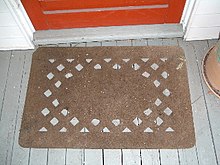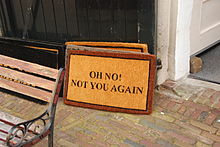Doormat
A doormat is a mostly rectangular small mat that is used for the rough cleaning of shoe soles and the purpose of which is to keep the apartment or house clean. It thus serves as a dirt lock . In most cases, it is located in front of the entrance door of an apartment , in front of front doors or in the entrance area of authorities and companies and is therefore used both indoors and outdoors. Floor mats in vehicles are often made of rubber and are usually shaken out for cleaning.
Material and texture


The doormat enables the soles of the shoes to be stripped off before entering the premises, so that the dirt remains on and between the fibers of the mat. Very often doormats are made of virgin wool , coarse, tapered plastic, coconut fibers or palm leaves . The durable sisal is also often used. There are also mats made of plastic, rubber, caoutchouc and roughly perforated or corrugated metal (stainless steel and aluminum) with knobs.
Due to the coarse profile, coconut fibers are only intended for use outside the home. About 40 nuts are needed to make a doormat from this material.
Household sizes are around 30 by 50 centimeters. In addition to the rectangular shape, the semicircular mat has also become common. A fiber or knob height of 1 to 2 cm enables quick cleaning by knocking out. Depending on the size and material, the mats are priced between two and 50 euros. Different colors, some mats also contain a woven or printed slogan or a symbol. Often you will find a welcome or the request to scrape the knuckle .
Further use
- Floor mats made of fabric and velor are also used as a bathtub template in the bathroom . These are then usually significantly larger. They are designed to protect bare feet from the cold tiles after a bath or shower. These floor mats are mostly non-slip with a rubber coating on the underside.
- Fluffy U-shaped floor mats do not have a generally recognized name. The writer Max Goldt speaks of "toilet foot puddles".
- The doormat in front of the bed is called a bed rugs .
- Floor mats rubber car dealers offer specially tailored to their various models ( car mat ). Here, too, the doormat, which takes into account the position of the pedals on the driver's side, prevents interior pollution. In the car sector, there are floor mats with a precise fit and embroidery.
Regional usage
Depending on the region, different terms are used for floor mats:
- Doormat and door mat in large parts of West Germany, and regionally in Southern Germany
- Doormats mainly in East Germany
- Doormats and shoe scrapers in large parts of southern Germany and Austria
- Foot cleaners , shoe cleaners , foot scrapers and scrapers in parts of Saxony
- Doormat and doormat both nationwide
- Door jackets in Austria
hazards
On the grounds of an increased risk of tripping in the event of a fire in a residential building, the city of Bristol requested in 2006 that the tenants of their communal apartments remove the floor mats from the corridors. The edges of the doormats should not stand up and the mats themselves should have "a non-slip layer on the back" .
Floor mats in the automotive sector
In the automotive sector, floor mats are placed in the footwell of the vehicle. They are available as textile or rubber floor mats.
Textile floor mats are typically made of polypropylene, polyamide or polyester fiber. They are available as tufted velor , needle felt or nonwoven mats .
The floor mats are available in different shapes. As a fit, so that they are exactly adapted to the footwell of a vehicle, as a semi and universal fit that have a typical footwell contour.
construction
Structure of tufted velor mats in the sandwich process:
- Upper fabric
- carrier
- Coating ( textile coating )
- Integration (latex)
- Precoat
- Second back (actionback, fleece or jute)
- Anti-slip back coating
Structure of needle felt mats:
- Upper fabric
- Coating ( textile coating )
- Involvement
- Latex precoat
- Anti-slip back coating
Tufted velor car mats have different pitches that are specified in inches 1/10 ', 5/64', 1/8 'and different yarn structures such as heat-set yarn, pearl velor or loop tuft. With needle felt car mats, there are single ribs, double ribs, multiple ribs, needle felt velor, needle felt dilor, lozenge design or jacquard needles.
Anti-slip coating
The different back coatings have different adhesive forces that have a positive effect on the lying behavior of the floor mats in the vehicle. The adhesive forces are determined by means of a pull-off test on various floor group carpets. Rubber granulate, NSF latex, Fibretec, PES foam, TPE coating or Maliwatt textile backing are used as backing.
Manufacturing
Manufacturing process of textile floor mats
- Determination of the raw material and roll material
- Determination of type of cut
- Fit - textile machines, semi-fit - textile machines, universal textile machines
- Determination of the type of shaping of the raw material
- Performed by means of punching processes, CNC cutter cutting, waterjet technology ( water jet cutting machine ), laser cutting ( laser cutting ), band knife cutting
- Possibly. Integration of the step protection
- Is used in the most stressed zone, in the area of the pedals. Protects this area against premature damage from wear and tear. All abrasion-resistant materials such as polyamide, PVC and specially treated needle felt are used as step protection. The step protection is applied by sewing or welding using high-frequency welding systems.
- Edging of the blanks
- Band edging consists of woven and knitted fabrics in various materials, designs, thicknesses, finishes and colors with which the textile blank is edged in order to protect it from fraying. Linking with yarns from different materials, effects, thicknesses and shapes with which the textile blank is linked in order to protect it from fraying. The edging also serves as a design element.
- Integration of the fastening systems
- To prevent slipping, some vehicles have a permanently installed stopper system with which the floor mats are attached to the floor assembly and slipping under the pedals is prevented. Vehicles that are not equipped with a standard stop system can secure the car mats with a retrofit fastening system.
Manufacture of rubber floor mats
Rubber floor mats are made from elastomers such as SBR ( styrene-butadiene-rubber ), EPDM ( ethylene-propylene-diene-rubber ), NR ( natural rubber ) or thermoplastic elastomers such as TPE-S, TPE-O. They consist of a mixture of these raw materials with fillers. In production, a distinction is made according to the respective crosslinking process, whether vulcanization or thermoplastic deformation.
During the pressing process, the mixture of raw materials on the tool is pressed into the mold under the influence of pressure, time and temperature. In the injection molding process ( injection molding ), the raw material mixture is injected into the empty tool under the influence of pressure and time and thus pressed into the respective shape.
Dangers when using floor mats
Slipping of the car mats in the vehicle, especially with the driver's mats under the pedals and thus the restriction of freedom of movement, effect of the functions. Setting up the mat corners (bowls) and rolling up the car mats in the vehicle due to the effects of moisture, especially with the driver's mat, can result in the car mats slipping under the pedals, which in turn limits the freedom of movement, effect and functions of the pedals.
Web links
Individual evidence
- ↑ Martin Lutz: Practical Guide for Building Cleaning . Landsberg / Lech 2008, p. 15.
- ↑ Max Goldt: Ä. Columns . Wilhelm-Heyne-Verlag, Munich 2000 (7th edition), ISBN 3-453-13715-9 . P. 135.
- ^ "Third round - doormat / doormat" , Atlas on German everyday language (AdA), Phil.-Hist. Faculty, University of Augsburg, June 19, 2006.
- ^ Carpet as a stumbling block ( Memento from July 17, 2012 in the Internet Archive )


